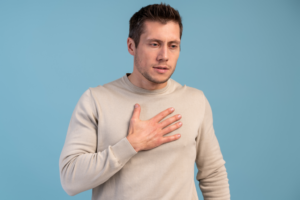Hypochondria and Nosophobia: Two Manifestations of the Fear of Illness


Written and verified by the psychologist Elena Sanz
Have you ever noticed a small lump on your skin and been almost sure it was a tumor? Have you felt a slight pang in your chest and prepared yourself to have a heart attack? These types of interpretations make up the daily life of many people who are permanently worried and anguished about illnesses and diseases. However, they’re not the only manifestation of this particular fear. For this reason, today, we want to talk to you about the differences between hypochondria and nosophobia.
Hypochondria is a fairly well-known disorder. In fact, the term, despite being technical, is often used colloquially. We know that it refers to the belief (practically the conviction) that someone has that they’re suffering from an undiagnosed disease.
On other occasions, this fear of illness manifests itself as anticipation. Therefore, sufferers fear developing a disease in the future, which causes them great discomfort. If you’re interested in learning more about these two conditions, read on.

Hypochondria: the fear of being sick
In the latest version of the Diagnostic and Statistical Manual of Mental Disorders (DSM-5), the term hypochondriasis has been replaced and is encompassed in two new categories of somatic symptom disorder and anxiety illness disorder. Hypochondria designates the firm belief or conviction that a person is suffering from a serious illness, generally as a result of a mild symptom. Therefore, it’s an erroneous and exaggerated interpretation of a physical signal in the body.
There are several characteristic behaviors of those who suffer from hypochondria:
- Their attention is focused on the body part they think is affected. It’s common for them to look at it or feel it repeatedly to confirm their hypothesis or detect any change.
- They spend a great deal of time searching for information on the Internet, in magazines, or in books about the disease they think they have, its symptoms, and any diagnostic tests.
- They constantly ask family and friends whether they think they’re healthy. However, when they try to reassure them and rationalize their symptoms, this only makes them feel isolated, misunderstood, and even more worried.
- They go from doctor to doctor in search of a diagnosis. In the short term, confirmation by a professional that they’re healthy will reassure them. But, in a short time, their doubts will resurface. They’ll think that the doctor was wrong, that the tests they performed weren’t adequate, or that they were carried out at the wrong time.
- The belief of being sick generates great suffering and levels of anxiety that, in turn, can increase the physical symptoms they’ve been experiencing and misinterpreting. Furthermore, as the assumed disease progresses, their work performance, finances, and social relationships are often affected.
Nosophobia: an anticipatory fear
With nosophobia, there’s also a fear of illness but, in this case, it’s a fear of getting sick in the future. The sufferer experiences an intense, irrational, and uncontrollable fear of contracting a disease, but their way of dealing with the fear is different:
- They avoid going to the doctor or having tests, even if they need them. This is in order to avoid confirming that they’re ill.
- They try not to talk about symptoms or illnesses, don’t watch movies or series on the subject, and avoid hospitals or spending time with sick people. That’s because, in these situations, their anxiety can skyrocket.
- They have a great fear of their own death and that of their loved ones.
- They’re also really afraid of aging and reject old age. For the same reason, they try to stay and look young.

The main differences between hypochondria and nosophobia
As you can see, despite the fact that fear of illness is central to both disorders, hypochondria and nosophobia present significant differences. The hypochondriac fears they’re sick now, while the nosophobia sufferer is afraid of getting sick in the future. In the first case, the sufferer pays attention to bodily symptoms and seeks information and answers. In the second, they try to avoid everything related to the disease and don’t want to know anything about it.
It’s quite common for hypochondriacal people to have had childhoods in which they were overprotected or that were marked by illness, either their own or that of loved ones. Similarly, they’ve often had to live with or care for sick people who’ve now died, which makes them see disease as something that’s constantly on the horizon.
Nosophobia usually occurs after the age of 40. In fact, it’s related to the fear of aging, decline, and death. As a result of the Covid-19 pandemic, cases have skyrocketed.
Despite their differences, these two disorders cause great suffering and treatment should always be sought. In both situations, cognitive-behavioral therapy is the most recommended treatment. Through relaxation techniques, exposure, and restructuring of beliefs, the sufferer can relieve their anxiety, adjust their perceptions, and reduce the impact of their fear of illness.
All cited sources were thoroughly reviewed by our team to ensure their quality, reliability, currency, and validity. The bibliography of this article was considered reliable and of academic or scientific accuracy.
- Fernández, C., & Fernández, R. (2001). Tratamientos psicológicos eficaces para la hipocondría. Psicothema, 13(3), 407-418.
- Lara, G. E., Baca-Salinas, J., & Reyes-Mendoza, L. G. (2021). Nosofobia como impacto negativo de la pandemia derivada del COVID-19. Boletín Científico de la Escuela Superior Atotonilco de Tula, 8(15), 56-60.
- Vallejo, M. Á. (2014). De los trastornos somatomorfos a los trastornos de síntomas somáticos y trastornos relacionados. Cuadernos de medicina psicosomática y psiquiatría de enlace, (110), 75-78.
This text is provided for informational purposes only and does not replace consultation with a professional. If in doubt, consult your specialist.








